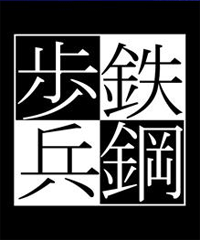Carrying on the Simple Spirit: Tekkou Hohei

Since the all-but-demise of D3 Publisher’s Simple series of budget games, I’ve missed its particular blend of hooks-and-wire, no-budget ingenuity in gaming. It’s improbable for that type of development model to exist in the form of disc- or cartridge-based releases in the game industry’s current climate, and D3 hasn’t moved its business model into the downloadable realm beyond a few token releases.
Lately, however, I’ve started looking at homebrew and otherwise independently-developed games available on Xbox Live Arcade’s Indie Games section. Certainly, there’s an awful lot of underdeveloped, unplayable, undergrad-CS projects full of programmer art among the 2000-plus titles available on the service. But at the same time, there are games that show plenty of ingenuity and make excellent use of the resources available to the small teams making them.
The first of these I want to look at is Tekkou Hohei (鉄鋼歩兵, which translates as Steel Infantry), a mecha shooter made by a Japanese team of two members. You pilot a robot that’s reminiscent of Front Mission and fight other robots in arena-like stages using small arms, rocket launchers, and plain old mecha fists.
The game controls like a first-person shooter, and indeed, one of the views available to you in-game is a first-person perspective. (There is no option to invert the controller’s Y axis, so beware if that’s a preference of yours.) Halo’s model of rechargeable shield plus depletable armor is present here, and the robots have the ability to speed-boost across the map for limited bursts. To do well at the game, you’ll need to use both cover and boost wisely. There’s a good range game at work here: rockets (long-range pain), rifles (ditto), assault rifles (medium range), shotguns (close-range), and a single melee attack that makes for point-blank instant death.
Continuing the Front Mission similarities, Tekkou Hohei allows you to customize your mecha with various parts and weapons, which you can purchase with funds you receive for completing missions. But while some parts are definitely better than others, there tend to be tradeoffs between different sets of stats more often than a linear upgrade path.
 I’ll be perfectly straight with you: this game is ugly. It’s hard to look at and hard to listen to. It might make you think of a lost Dreamcast prototype that was cancelled for lack of funding. Or, you could say that it looks like a Simple 2000 game made for PS2. It’s also difficult, especially at the beginning. Until you get used to the game’s controls, you may find yourself frustrated with the game and dying quickly. But after you’ve added a couple of part upgrades and practiced the first mission enough to be able to boost around in your robot with relative agility, you’ll find that the game rewards speedy, risk-taking, cool-looking tactics. And that’s where the game shines.
I’ll be perfectly straight with you: this game is ugly. It’s hard to look at and hard to listen to. It might make you think of a lost Dreamcast prototype that was cancelled for lack of funding. Or, you could say that it looks like a Simple 2000 game made for PS2. It’s also difficult, especially at the beginning. Until you get used to the game’s controls, you may find yourself frustrated with the game and dying quickly. But after you’ve added a couple of part upgrades and practiced the first mission enough to be able to boost around in your robot with relative agility, you’ll find that the game rewards speedy, risk-taking, cool-looking tactics. And that’s where the game shines.
Tekkou Hohei is great at simulating the kind of fluid, deadly battles seen in mecha anime. Player and enemy units boost around with ease, and as stages go on, the game keeps the pressure on, sending in enemies with heavier weaponry and more aggressive tactics. You’ll be required to fine-tune your piloting skills just as you flesh out your robot using parts that suit your style of attack. When you’re out of ammo and you deliver a coup de grace to that last enemy unit with a desperate melee attack, you’ll know what the game is all about.
If this game were released on a disc as a Simple 2000 Series title (for ~$USD25), I’d find it interesting enough to buy. So at 80 MS Points ($1) I can easily recommend it to anybody who has a passing interest in Japanese robots or the Simple Series flavor.
Sounds interesting enough, and it’s cool that some people are using this distribution form as an outlet. Too bad my 360 is still busted. >_<